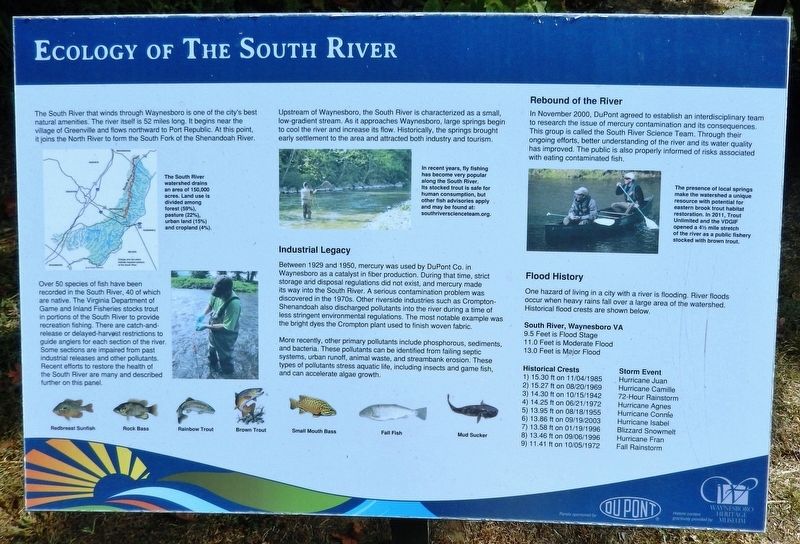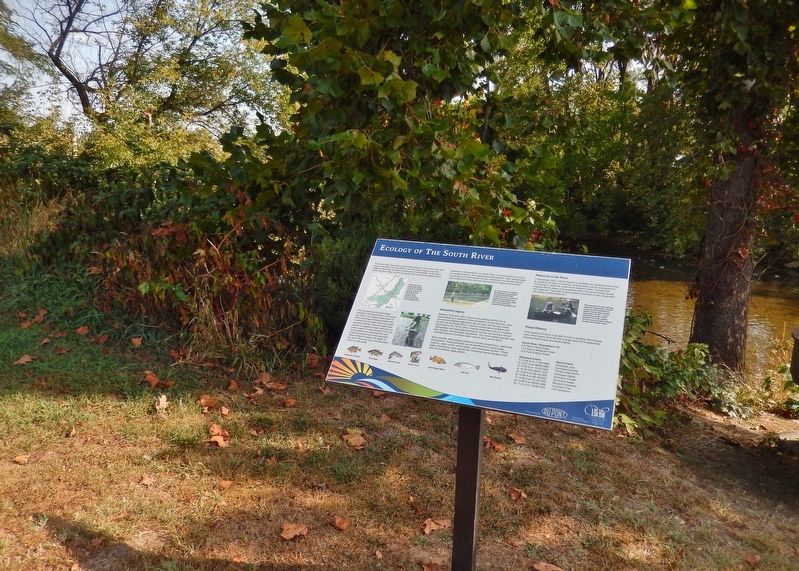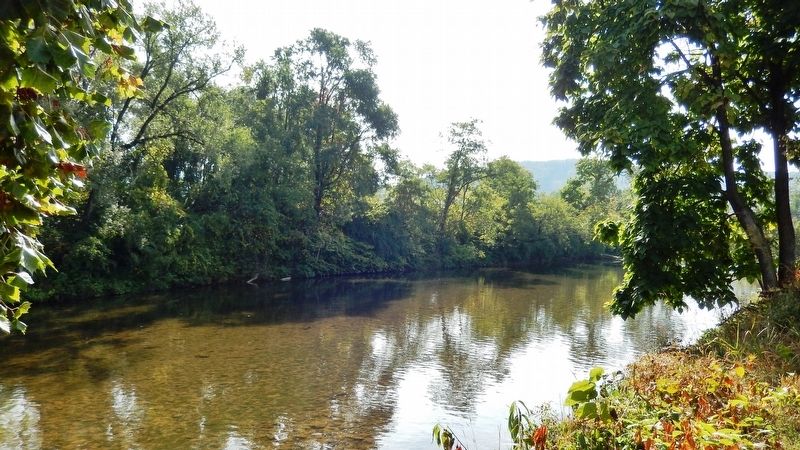Waynesboro, Virginia — The American South (Mid-Atlantic)
Ecology of the South River
Over 50 species of fish have been recorded in the South River, 40 of which are native. The Virginia Department of Game and Inland Fisheries stocks trout in portions of the South River to provide recreation fishing. There are catch-and-release or delayed-harvest restrictions to guide anglers for each section of the river. Some sections are impaired from past industrial releases and other pollutants. Recent efforts to restore the health of the South River are many and described further on this panel.
Upstream of Waynesboro, the South River is characterized as a small, low-gradient stream. As it approaches Waynesboro, large springs begin to cool the river and increase its flow. Historically, the springs brought early settlement to the area and attracted both industry and tourism.
In recent years, fly fishing has become very popular along the South River. Its stocked trout is safe for human consumption, but other fish advisories apply and may be found at: southriverscienceteam.org.
Industrial Legacy
Between 1929 and 1950, mercury was used by DuPont Co. in Waynesboro as a catalyst in fiber production. During that time, strict storage and disposal regulations did not exist, and mercury made its way into the South River. A serious contamination problem was discovered in the 1970s. Other riverside industries such as Crompton-Shenandoah also discharged pollutants into the river during a time of less stringent environmental regulations. The most notable example was the bright dyes the Crompton plant used to finish woven fabric.
More recently, other primary pollutants include phosphorous, sediments, and bacteria. These pollutants can be identified from failing septic systems, urban runoff, animal waste, and streambank erosion. These types of pollutants stress aquatic life, including insects and game fish, and can accelerate algae growth.
Rebound of the River
In November 2000, DuPont agreed to establish an interdisciplinary team to research the issue of mercury contamination and its consequences. This group is called the South River Science Team. Through their ongoing efforts, better understanding of the river and its water quality has improved. The public is also properly informed of risks associated with eating contaminated fish.
The presence of local springs make the watershed a unique resource with potential for eastern brook trout habitat restoration.
In 2011, Trout Unlimited and the VDGIF opened a 4 ½ mile stretch of the river as a public fishery stocked with brown trout.
Flood History
One hazard of living in a city with a river is flooding. River floods occur when heavy rains fall over a large area of the watershed. Historical flood crests are shown below.
South River, Waynesboro VA
• 9.5 Feet is Flood Stage
• 11.0 Feet is Moderate Flood
• 13.0 Feet is Major Flood
Historical Crests
1) 15.30 ft on 11/04/1985 • Hurricane Juan
2) 15.27 ft on 08/20/1969 • Hurricane Camille
3) 14.30 ft on 10/15/1942 • 72-Hour Rainstorm
4) 14.25 ft on 06/21/1972 • Hurricane Agnes
5) 13.95 ft on 08/18/1955 • Hurricane Connie
6) 13.86 ft on 09/19/2003 • Hurricane Isabel
7) 13.58 ft on 01/19/1996 • Blizzard Snowmelt
8) 13.46 ft on 09/06/1996 • Hurricane Fran
9) 11.41 ft on 10/05/1972 • Fall Rainstorm
Erected by DuPont and the Waynesboro Heritage Museum.
Topics. This historical marker is listed in these topic lists: Environment • Industry & Commerce • Parks & Recreational Areas • Waterways & Vessels.
Location. 38° 4.033′ N, 78° 53.077′ W. Marker is in Waynesboro, Virginia. Marker can be reached from Short Street east of Race Avenue, on the left when traveling east. Marker is located on the east side of Constitution Park, along the South River Greenway trail. Touch for map. Marker is at or near this postal address: 101 Short Street, Waynesboro VA 22980, United States of America. Touch for directions.
Other nearby markers. At least 8 other markers are within walking distance of this marker. William H. Harman Monument (about 400 feet away, measured in a direct line); River Crossings & Bridges (about 400 feet away); Waynesboro (about 600 feet away); a different marker also named Waynesboro (approx. ¼ mile away); Fishburne Military School (approx. 0.3 miles away); Port Republic Road Historic District (approx. 0.6 miles away); W. J. Loth (approx. 0.6 miles away); Wooden Water Pipe (approx. 0.6 miles away). Touch for a list and map of all markers in Waynesboro.
Also see . . . South River Science Team. The South River Science Team was established in 2001 and, with a shared goal, quickly expanded to include not only the DEQ and DuPont but also the Department of Health; Department of Game and Inland Fisheries; and representatives from academia, citizen groups, and the Environmental Protection Agency. Today, Science Team members continue to work together to achieve the ultimate goal of reducing mercury levels in fish. (Submitted on October 5, 2019, by Cosmos Mariner of Cape Canaveral, Florida.)
Credits. This page was last revised on November 16, 2022. It was originally submitted on October 2, 2019, by Cosmos Mariner of Cape Canaveral, Florida. This page has been viewed 370 times since then and 63 times this year. Photos: 1. submitted on October 2, 2019, by Cosmos Mariner of Cape Canaveral, Florida. 2, 3. submitted on October 5, 2019, by Cosmos Mariner of Cape Canaveral, Florida.


